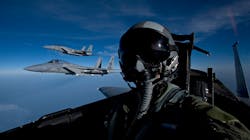Air Force asks industry to blend cockpit sensors to send alerts about potential degraded pilot health
WRIGHT-PATTERSON AFB, Ohio – U.S. Air Force researchers are asking industry for new ways of capitalizing on combat jet avionics sensors to send alerts concerning degraded pilot health brought on by the rigors of flight in high performance aircraft.
Officials of the Air Force Research Laboratory at Wright-Patterson Air Force Base, Ohio, issued a notice on Wednesday (AFRL-711-RHX-002) for the Air Force Research Laboratory Airman Systems Directorate - Request for Information.
This project seeks to develop technologies to monitor and alert pilots to potential concerns with their physiological states in flight, such as a gradual reduction in oxygen flow or extremes in G forces that could impair pilot performance.
The project focuses on integrating and demonstrating existing sensor technologies and assessment techniques. Researchers particularly are interested in integrated sensors; air-quality monitoring; sensor fusion; pilot vital signs monitoring; flight environment monitoring; respiratory function monitoring; data storage and processing; onboard analytics; and pilot alerts.
Related: Air Force looks to DRS to upgrade aircraft pilot electronic-warfare training equipment
Integrated sensors involves hardware to integrate several sensors. This hardware must be self-contained, self-powered, and small and lightweight enough to integrate easily into the aircraft cockpit.
Such hardware could involve small-form-factor embedded computing, smart phones, or tablet computers -- including wireless connectivity like BlueTooth Low Energy.
Software design standards will be provided by the Air Force -- specifically the Cognitive Operations Gear Pack (COG Pack) open-architecture API standard.
Air-quality monitoring covers aircraft life-support systems via in-line sensor technologies. Air quality should include oxygen, carbon dioxide, pressure, flow, and likely contaminants.
Sensor fusion involves the COG Pack emerging open architecture API standard proposed to enable ingestion, storage, processing, publishing, and retransmission of data from several different sensor inputs.
Pilot vital signs involves sensor systems that provide direct or indirect evidence of pilot blood circulation, blood or tissue oxygenation, heart or pulse rate and variability, peripheral capillary oxygen saturation (SpO2), estimated core temperature, and respiration rate.
Flight environment addresses basic environmental parameters like cabin pressure, temperature, and acceleration that are part of another component or a separate component.
Respiratory function provides respiration rate data that address work of breathing and metabolic output.
Data storage and processing seeks to provide sufficient space and computing power to enable at least nine to 12 hours of data storage and processing capacity. A post-flight system should offload into a repository for long-term retention.
Onboard analytics must be able to generate derived parameters, apply decision rules or algorithms, and generate alerts and recommended corrective actions to the pilot.
Related: Lightweight night-vision goggles for commercial aviation aircraft pilots introduced by ASU
Pilot alerting must provide easily perceptible and interpretable alerts to the pilot using visual, auditory, and haptic cues to make sure the pilot notices and understands these alerts.
Companies interested should email five-page responses no later than 3 Jan. 2020 to the Air Force's James Christiansen at [email protected], with a copy to Joseph Mizzi at [email protected].
More information is online at https://beta.sam.gov/opp/3ab63b3d6a094863b9b5a62e54ca51b6/view.
